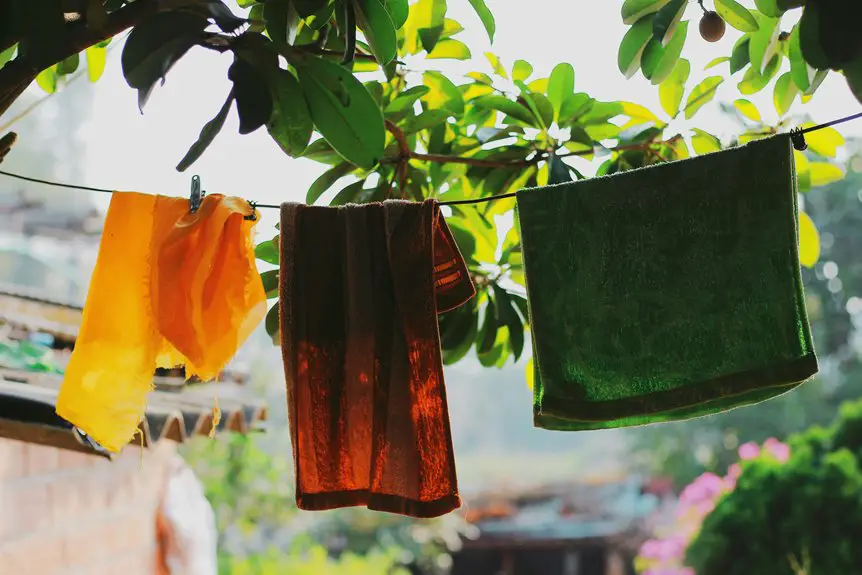Did you know that the right fabric can greatly impact your comfort, no matter the weather? Breathability plays an essential role in how we feel throughout the day, affecting everything from temperature regulation to moisture management. Choosing the right breathable material can enhance your daily activities, but not all fabrics are created equal. Understanding what makes a fabric breathable can help you make informed choices for your wardrobe.
Table of Contents
Key Takeaways
- Fabric breathability enhances comfort by allowing air circulation, crucial in both hot and humid climates.
- Natural fibers like cotton and linen are highly breathable, making them ideal for warm weather wear.
- Breathable fabrics help regulate temperature, preventing clamminess and skin irritation during physical activities.
- Moisture management is essential; breathable materials wick away sweat, keeping the body dry and comfortable.
- Innovations in fabric technology continue to improve breathability, ensuring comfort across various conditions and promoting sustainability.
Understanding Fabric Breathability
When you think about comfort in clothing, fabric breathability often takes center stage. Breathable fabrics allow air to flow, keeping you cool and comfortable, especially in warm weather. They help wick away sweat, preventing you from feeling clammy and sticky.
Understanding fabric breathability means recognizing how materials interact with moisture and temperature. Natural fibers like cotton and linen are known for their breathability, while synthetic options like polyester may vary. The right fabric can make a significant difference in your daily comfort.
Whether you’re lounging at home or active outdoors, breathable fabrics enhance your experience by allowing your skin to breathe. Choosing the right clothing based on breathability can help you stay comfortable regardless of the climate.
Testing Methods for Breathable Fabrics
When it comes to testing breathable fabrics, you’ll find several common techniques in use today.
These methods help measure breathability ratings and guarantee that the materials perform well in real-world conditions.
Understanding these testing methods can guide you in choosing the right fabric for your needs.
Common Testing Techniques
To determine how breathable a fabric is, various testing techniques are employed, each designed to measure air permeability effectively.
One common method is the air permeability test, which measures the amount of air that can pass through a fabric under specific pressure conditions.
Another approach is the moisture vapor transmission rate (MVTR) test, evaluating how well a fabric allows moisture vapor to escape, essential for comfort.
Additionally, you might encounter the water vapor permeability test, which examines the fabric’s ability to manage humidity.
These tests provide valuable insights into a fabric’s performance in different climates, helping you choose the right material for your needs.
Measuring Breathability Ratings
Measuring breathability ratings involves a variety of methods that provide quantitative data on how well a fabric allows air and moisture to pass through.
One common technique is the moisture vapor transmission rate (MVTR) test, which measures how much moisture escapes from the fabric over time.
Another method is the air permeability test, where air is pushed through the fabric to quantify how easily it flows.
You might also encounter the hydrostatic head test, which determines a fabric’s resistance to water penetration while evaluating breathability.
Each method gives you valuable insights into a fabric’s performance under different conditions.
Understanding these ratings helps you make informed choices for your clothing and gear, ensuring comfort in any climate.
Real-World Performance Validation
While understanding breathability ratings is important, it’s equally essential to see how these fabrics perform in real-world scenarios.
You can’t just rely on numbers; testing methods like controlled climate chambers and wear trials provide critical insights.
In a climate chamber, fabrics are subjected to varying temperatures and humidity levels, simulating real-life conditions. This helps gauge how well a material wicks moisture and allows air to flow.
Wear trials take things a step further, putting garments on actual users during physical activities. Observing how fabrics react in sweat-inducing situations reveals their true breathability.
Benefits of Choosing Breathable Materials
When you choose breathable materials, you’re investing in enhanced comfort levels that keep you feeling fresh all day.
This comfort can translate into improved performance output, whether you’re working out or just going about your daily routine.
Let’s explore how breathable fabrics can make a real difference in your life.
Enhanced Comfort Levels
Choosing breathable materials greatly enhances your comfort levels, as they allow air to circulate and moisture to escape. When you wear fabrics that promote breathability, you’ll feel cooler in hot weather and warmer in cooler conditions. This natural temperature regulation helps prevent that clammy feeling, keeping you dry and comfortable throughout the day.
Additionally, breathable fabrics reduce the risk of skin irritation, as they minimize friction and allow your skin to breathe. You’ll notice that your clothes feel lighter and less restrictive, making it easier to move freely.
Ultimately, choosing breathable materials means you can enjoy your activities without the discomfort of trapped heat and humidity. Embrace the difference, and experience comfort like never before!
Improved Performance Output
Breathable materials not only enhance comfort but also greatly boost your performance output during physical activities. When you wear fabrics that allow air circulation, you stay cooler and drier, preventing overheating. This means you can push yourself harder and longer without feeling drained.
Additionally, breathable fabrics wick away moisture, reducing chafing and distractions that could derail your focus. You’ll notice improved stamina and agility, letting you move freely and confidently.
Whether you’re running, cycling, or engaging in any sport, choosing breathable materials helps your body maintain ideal temperature regulation. Ultimately, this leads to more effective workouts and better results, making breathable fabrics a smart choice for anyone serious about their performance.
Types of Breathable Fabrics Available
While you might think all fabrics are created equal, the reality is that various materials offer different levels of breathability, making them better suited for specific activities and climates.
Understanding the types of breathable fabrics can help you choose the right gear for your needs. Here are three popular options:
- Cotton: A natural fiber known for its softness and moisture-wicking properties, making it ideal for casual wear in moderate climates.
- Linen: Extremely breathable and lightweight, linen is perfect for hot weather as it allows air to flow freely.
- Polyester: Often used in activewear, this synthetic fabric is designed to wick moisture away from your skin while remaining breathable during intense workouts.
Choosing the right fabric can greatly enhance your comfort levels.
Challenges in Breathability Performance
Although many fabrics claim to be breathable, several challenges can affect their actual performance. One major issue is moisture management; if a fabric absorbs too much sweat, it can become saturated and lose its breathability.
Additionally, fabric construction plays an essential role—tight weaves or dense materials can restrict airflow, counteracting breathability benefits. Environmental factors like humidity can also impede performance; high humidity levels may prevent moisture from evaporating efficiently.
Furthermore, finishes and treatments applied to fabrics can alter their breathability. Even the weight of the fabric matters; heavier materials might trap heat and moisture, leading to discomfort.
Understanding these challenges will help you make informed choices when selecting breathable fabrics for various climates.
Future Trends in Breathable Fabric Development
With an understanding of the challenges affecting breathability, it’s exciting to look ahead at the innovations shaping the future of breathable fabric development.
You’ll want to keep an eye on these trends:
- Smart Fabrics: These materials incorporate sensors and technology, adapting to your body temperature and activity level for ideal comfort.
- Sustainable Materials: Eco-friendly fabrics made from recycled or organic sources are becoming more popular, offering breathability without compromising the planet.
- Enhanced Moisture Management: Innovations in fiber technology allow for better moisture-wicking properties, keeping you dry and comfortable in various conditions.
These advancements promise to elevate your experience, making breathable fabrics more functional and sustainable than ever before.
Stay tuned for these exciting developments!
Frequently Asked Questions
How Do I Care for Breathable Fabrics?
Did you know that breathable fabrics can reduce sweat retention by up to 50%? To care for them, wash in cold water, avoid fabric softeners, and air dry to maintain their performance and longevity.
Can Breathable Fabrics Be Waterproof Too?
Yes, breathable fabrics can be waterproof, but it depends on the material and construction. Look for options like Gore-Tex or other laminates that offer both breathability and waterproofing, ensuring comfort in various conditions.
Are Breathable Fabrics Suitable for Winter Wear?
Oh sure, let’s wear breathable fabrics in winter and freeze! Actually, breathable fabrics can work for winter wear if they’re layered correctly, keeping you warm without trapping moisture. Just don’t expect them to be miracle workers!
Do Breathable Fabrics Lose Their Effectiveness Over Time?
Yes, breathable fabrics can lose their effectiveness over time due to wear, washing, and exposure to elements. Regular maintenance and proper care can help prolong their breathability and overall performance, so keep an eye on them.
How Can I Identify Breathable Fabrics When Shopping?
When shopping, look for lightweight materials like cotton, linen, or moisture-wicking synthetics. Check for labels indicating breathability, and feel the fabric; it should be soft and allow air to flow easily.
- Why Open-Weave Scrim Is the Secret to Stunning Event and Canopy Designs - June 26, 2025
- Creating Large-Scale Art Installations With Scrim Fabric - June 26, 2025
- Scrim Fabric in Upholstery: Understanding Its Use as a Backing Material - June 26, 2025







